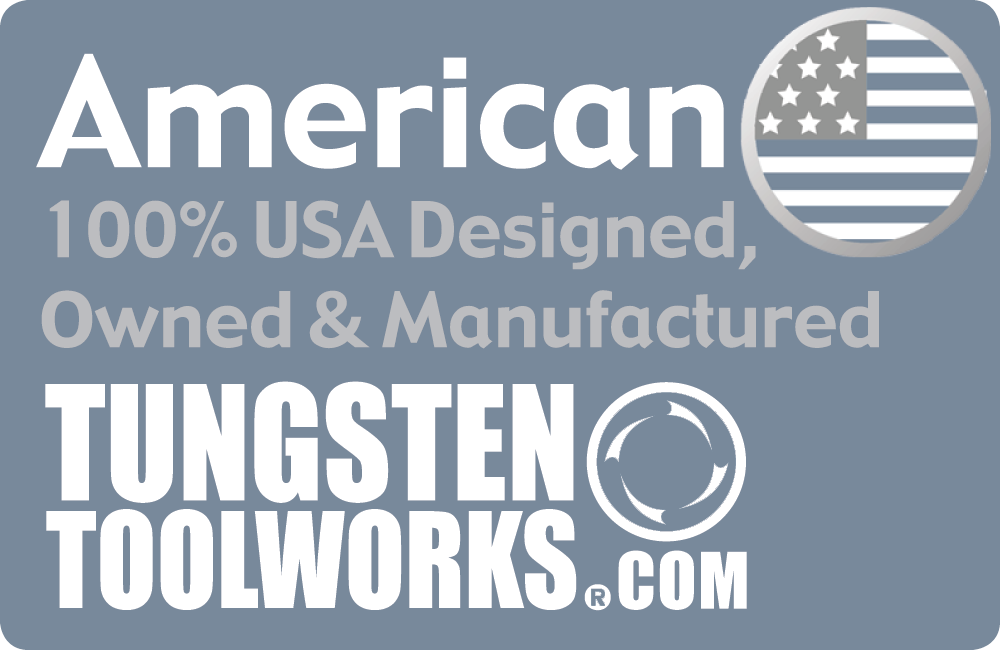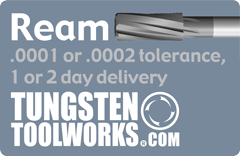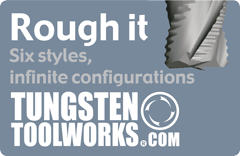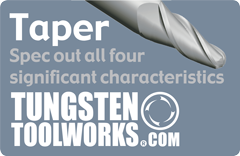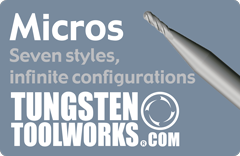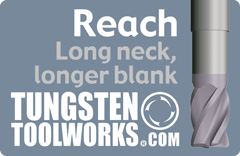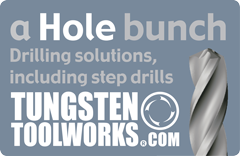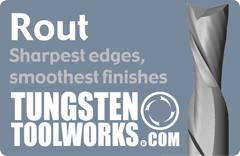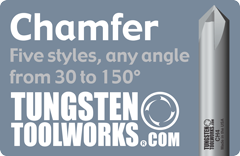|
Troubleshooting
Carbide End Mills | Carbide Drills | Carbide Reamers
|
Problem
|
Cause
|
Solution
|
|
Chipping
|
Feed rate too high
Up milling (conventional)
Cutting edge too sharp
Chattering
Loose tool
Workpiece rigidity
Tool rigidity
Low cutting speed
Loose toolholder
|
Reduce feed rate
Change to down milling (climb)
Hone cutting edge or allow break-in
Reduce RPM
Remove, clean, and retighten
Tighten workpiece holding method
Shorten LOC, place shank further up holder
Increase RPM
Remove from spindle, clean and replace
|
|
Wear
|
High cutting speed
Low feed rate
Up milling (conventional)
Hard material
Poor chip evacuation
Improper cutter helix
Poor coolant
|
Reduce RPM
Increase feed rate
Change to down milling (climb)
Use coated tool
Reposition coolant lines, use air blasting
Change to recommended helix angle
Replace coolant or correct mixture
|
|
Breakage
|
Feed rate too high
Depth of cut too large
Poor tool rigidity
Tool wear
Poor chip evacuation
|
Reduce feed rate
Reduce depth of cut
Shorten LOC, place shank further up holder
Replace/regrind sooner
Reposition coolant lines, use air blasting
|
|
Chattering
|
Speed and feed too high
Poor toolholder rigidity
Poor spindle rigidity
Workpiece rigidity
Relief angle too high
Depth of cut too large
Poor tool rigidity
|
Reduce feed rate
Replace with shorter/more rigid holder
Use larger spindle or different machine tool
Tighten workpiece holding method
Regrind with smaller relief angle
Reduce depth of cut
Shorten LOC, place shank further up holder
|
|
Short Life
|
Cutter/workpiece friction
Hard material
Poor material condition
Improper cutter angle
Poor coolant
|
Use coated tool
Use coated tool
Use coated tool, clean material surface
Regrind with proper primary relief angle
Replace coolant or correct mixture
|
|
Chip Packing
|
Feed rate too high
Low cutting speed
Insufficient chip room
Insufficient coolant
|
Reduce feed rate or increase speed
Increase RPM or reduce feed rate
Use tool with less flutes, increase helix
Increase volume of coolant
|
|
Poor Surface Finish
|
Feed rate too high
Low cutting speed
Tool wear
Edge build up
Depth of cut too large
Chip welding
|
Reduce feed rate
Increase RPM
Replace or regrind tool
Increase RPM, switch to higher helix tool
Reduce depth of cut
Increase volume of coolant
|
|
Burring or Workpiece Chipping
|
Tool wear
Improper helix angle
Feed rate too high
Depth of cut too large
|
Replace or regrind tool
Change to recommended helix angle
Reduce feed rate
Reduce depth of cut
|
|
Workpiece Inaccuracy
|
Loose/worn toolholder
Poor toolholder rigidity
Poor spindle rigidity
Insufficient number of flutes
Tool deflection
|
Repair or replace
Replace with shorter/more rigid toolholder
Use larger spindle or different machine tool
Use tool with higher flute quantity
Shorten LOC, place shank further up holder
|
|
|
|
Tungsten ToolWorks is a manufacturer of customized (special) solid carbide cutting tools, sold worldwide under the Tungsten ToolWorks brand name. Products include solid carbide end mills, drills, reamers, burrs, micro tools, sub-miniature tools, micro tools, engraving tools, boring tools, keyseat cutters, burrs, slitting saws, carbide cylinders, countersinks, routers, radius mills, CBN tools, compression tools, and more. Technologies include SmoothCoat PVD hard coatings, SmoothGrind polished cutting edges, SmoothEdge prep and hone, and SmoothContricity shrink fit ready shanks. Coatings include D2 CVD diamond, D1 PVD amorphous diamond, TA TiAlN, AT AlTiN, TN TiN, TC TiCN, and A1 TiB2. Industries using our products include aerospace, semiconductor, die & mold, micro (nano) machining, woodworking, medical, consumer electronics, automotive and more. Workpiece materials to be drilled, milled, reamed, routed, engraved and more include titanium (6Al-4V, 5553), stainless (303, 304, 316, 410, 420, 440C, 15-5, 17-4, 13-8, 316L), tool steels (A2, D2, H13), general steels (1018, 1020, 4140, 4340, P20), Inconel (625, 718), cast iron, non-ferrous materials including aluminum, copper, brass, bronze, wood & plastics, CFRP (carbon fiber reinforced plastic), graphite, composites, fiberglass, and more. Tungsten ToolWorks is a Tool Alliance company.
Copyright © 2024 Tool Alliance. All rights reserved.



